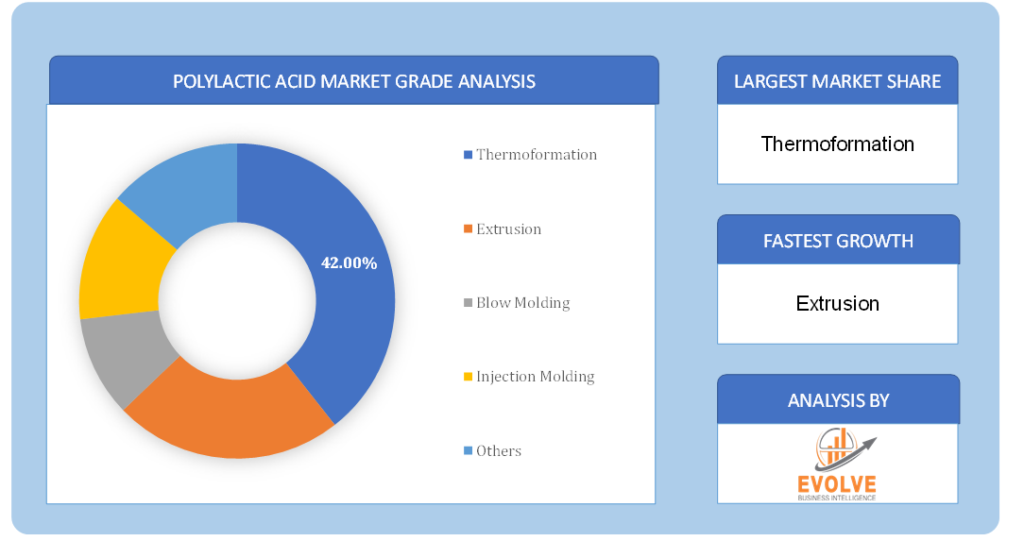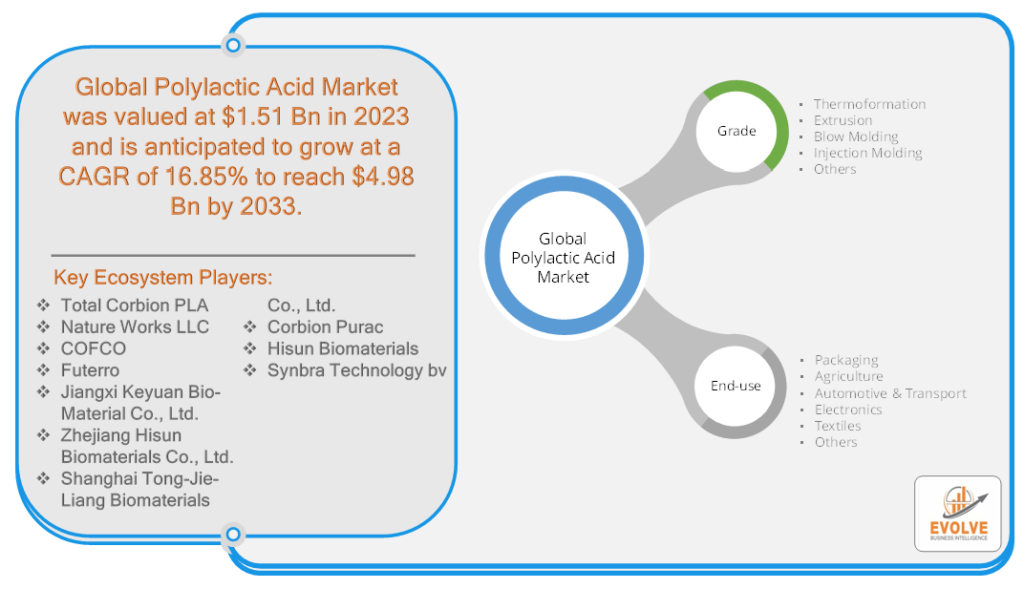Polylactic Acid Market Analysis and Global Forecast 2023-2033
$ 1,390.00 – $ 5,520.00Price range: $ 1,390.00 through $ 5,520.00
Polylactic Acid Market Research Report: Information By Grade (Thermoformation, Extrusion, Blow Molding, Injection Molding, Others), By End-use (Packaging, Agriculture, Automotive & Transport, Electronics, Textiles, Others), and by Region — Forecast till 2033
Polylactic Acid Market Overview
The Polylactic Acid Market Analysis Size is expected to reach USD 4.98 Billion by 2033. The Polylactic Acid industry size accounted for USD 1.51 Billion in 2023 and is expected to expand at a compound annual growth rate (CAGR) of 16.85% from 2023 to 2033. Polylactic Acid (PLA) is a biodegradable and bio-based polymer that belongs to the family of thermoplastics. It is derived from renewable resources such as cornstarch, sugarcane, or other agricultural feedstocks. PLA exhibits properties similar to conventional petroleum-based plastics while offering distinct environmental advantages. It possesses good transparency, excellent moldability, and thermal stability. PLA can be processed using various manufacturing techniques, including injection molding, extrusion, and 3D printing. As a sustainable alternative to traditional plastics, PLA finds applications in various industries, including packaging, textiles, medical devices, disposable utensils, and agricultural films. It has gained popularity due to its biodegradability, reduced carbon footprint, and compatibility with circular economy principles.
Global Polylactic Acid Market Synopsis
The COVID-19 pandemic had a significant and transformative impact on the Polylactic Acid (PLA) market. With a growing emphasis on sustainability and environmental concerns, PLA had already been experiencing increasing demand as a bio-based and biodegradable alternative to traditional plastics. However, the pandemic further amplified the importance of sustainable solutions, as it highlighted the vulnerabilities and risks associated with single-use plastics. The need for safer and more environmentally friendly packaging materials, medical supplies, and hygiene products surged during the pandemic. This led to heightened demand for PLA in various applications, including food packaging, personal protective equipment, and medical devices. The pandemic catalyzed the adoption of PLA and accelerated the transition towards more sustainable materials, contributing to the overall growth and transformation of the PLA market.
Polylactic Acid Market Dynamics
The major factors that have impacted the growth of Polylactic Acid are as follows:
Drivers:
Growing environmental concerns and sustainability initiatives
One of the major drivers of the Polylactic Acid (PLA) market is the increasing environmental concerns and sustainability initiatives worldwide. PLA is derived from renewable resources, such as cornstarch or sugarcane, and is biodegradable, making it an attractive alternative to petroleum-based plastics. The demand for PLA is driven by the desire to reduce reliance on fossil fuels, minimize carbon footprint, and address plastic pollution issues.
Restraint:
- Higher production costs compared to traditional plastics
A significant restraint for the Polylactic Acid market is the relatively higher production costs of PLA compared to traditional plastics. The production process of PLA requires specialized equipment and technologies, as well as a consistent supply of raw materials. These factors contribute to the higher overall cost of PLA production, which can limit its widespread adoption, particularly in price-sensitive markets or industries.
Opportunity:
Expanding applications in various industries
An opportunity for the Polylactic Acid market lies in the expanding range of applications across various industries. PLA’s versatile properties, including its ability to be molded into different shapes and forms, make it suitable for packaging, textiles, medical devices, disposable utensils, and more. As sustainability becomes a priority for businesses and consumers, the demand for PLA in these industries is expected to increase. Additionally, advancements in PLA production technologies and increasing economies of scale have the potential to lower production costs, opening up new opportunities for market growth.
Polylactic Acid Segment Overview
By Grade
 Based on Grade, the market is segmented based on Thermoformation, Extrusion, Blow Molding, Injection Molding, and Others. The Thermoformation segment is expected to have a larger market share throughout the forecast period. Thermoforming is a widely adopted manufacturing process that involves heating and molding PLA sheets into desired shapes and forms. It offers cost-effectiveness, versatility, and efficiency in producing various products such as packaging trays, containers, cups, and lids. The growing demand for sustainable packaging solutions in industries such as food and beverage, healthcare, and cosmetics is driving the adoption of thermoformed PLA products.
Based on Grade, the market is segmented based on Thermoformation, Extrusion, Blow Molding, Injection Molding, and Others. The Thermoformation segment is expected to have a larger market share throughout the forecast period. Thermoforming is a widely adopted manufacturing process that involves heating and molding PLA sheets into desired shapes and forms. It offers cost-effectiveness, versatility, and efficiency in producing various products such as packaging trays, containers, cups, and lids. The growing demand for sustainable packaging solutions in industries such as food and beverage, healthcare, and cosmetics is driving the adoption of thermoformed PLA products.
By End-use
Based on End-use, the market has been divided into Packaging, Agriculture, Automotive & Transport, Electronics, Textiles, and Others. The Packaging segment is anticipated to dominate the market. The increasing consumer demand for eco-friendly packaging solutions, coupled with stringent regulations on plastic waste and pollution, is driving the adoption of PLA in the packaging industry. PLA offers excellent clarity, barrier properties, and printability, making it suitable for various packaging applications, including bottles, containers, films, and bags.
Global Polylactic Acid Market Regional Analysis
Based on region, the global Polylactic Acid market has been divided into North America, Europe, Asia-Pacific, the Middle East & Africa, and Latin America. North America is projected to dominate the use of the Polylactic Acid market followed by the Asia-Pacific and Europe regions.
 North America Market
North America Market
North America has indeed consistently held a dominant position in the Polylactic Acid (PLA) market. The region’s dominance can be attributed to several factors. Firstly, North America has a strong focus on sustainability and environmental initiatives, which has driven the demand for PLA as a bio-based and biodegradable alternative to conventional plastics. The region’s advanced manufacturing capabilities, research and development infrastructure, and supportive regulatory frameworks have facilitated the growth of the PLA market. Additionally, North America boasts a robust packaging industry, where PLA finds extensive applications. Furthermore, the presence of major market players, technological advancements, and collaborations between industry participants in the region have contributed to North America’s dominant position in the Polylactic Acid market. However, as sustainability gains traction globally and demand for PLA rises in other regions, the market landscape is expected to become more competitive and geographically diversified in the coming years.
Asia-Pacific Market
The Asia-Pacific region has emerged as a rapidly growing market for the Polylactic Acid (PLA) industry. The region’s expanding population, rising disposable incomes, and increasing awareness of environmental sustainability have contributed to the growing demand for PLA. Countries such as China, Japan, South Korea, and India are witnessing significant growth in various industries, including packaging, textiles, and consumer goods, which are key application areas for PLA. Additionally, supportive government policies and regulations promoting the use of bio-based and biodegradable materials further drive the adoption of PLA in the region. Moreover, the Asia-Pacific region is home to several PLA manufacturers, fostering local production and supply chains. With its strong market potential, the Asia-Pacific region presents lucrative opportunities for both domestic and international players in the Polylactic Acid industry.
Competitive Landscape
The Global Polylactic Acid market is highly competitive, with numerous players offering a wide range of software solutions. The competitive landscape is characterized by the presence of established companies, as well as emerging startups and niche players. To increase their market position and attract a wide consumer base, the businesses are employing various strategies, such as product launches, and strategic alliances.
Prominent Players:
- Total Corbion PLA
- Nature Works LLC
- COFCO
- Futerro
- Jiangxi Keyuan Bio-Material Co., Ltd.
- Zhejiang Hisun Biomaterials Co., Ltd.
- Shanghai Tong-Jie-Liang Biomaterials Co., Ltd.
- Corbion Purac
- Hisun Biomaterials
- Synbra Technology bv
Key Development
In June 2022, NatureWoks LLC initiated the construction of a new manufacturing facility in Thailand dedicated to producing PLA polymer. With an expected annual capacity of 75,000 tons, this facility aims to meet the growing demand for PLA in various industries.
In January 2021, Sulzer Chemtech secured a contract to supply lactide production equipment for a project at Zhejiang Depei New Material Co.’s latest plant located in Ningbo, Zhejiang Province, China. This collaboration highlights the increasing focus on PLA production and underscores the importance of advanced manufacturing equipment in meeting the rising demand for PLA materials.
Scope of the Report
Global Polylactic Acid Market, by Grade
- Thermoformation
- Extrusion
- Blow Molding
- Injection Molding
- Others
Global Polylactic Acid Market, by End-use
- Packaging
- Agriculture
- Automotive & Transport
- Electronics
- Textiles
- Others
Global Polylactic Acid Market, by Region
- North America
- US
- Canada
- Mexico
- Europe
- UK
- Germany
- France
- Italy
- Spain
- Benelux
- Nordic
- Rest of Europe
- Asia Pacific
- China
- Japan
- South Korea
- Indonesia
- Austalia
- Malaysia
- India
- Rest of Asia Pacific
- South America
- Brazil
- Argentina
- Rest of South America
- Middle East & Africa
- Saudi Arabia
- UAE
- Egypt
- South Africa
- Rest of Middle East & Africa
| Parameters | Indicators |
|---|---|
| Market Size | 2033: $57.21 Billion |
| CAGR | 16.85% CAGR (2023-2033) |
| Base year | 2022 |
| Forecast Period | 2023-2033 |
| Historical Data | 2021 |
| Report Coverage | Revenue Forecast, Competitive Landscape, Growth Factors, and Trends |
| Key Segmentations | Grade, End-use |
| Geographies Covered | North America, Europe, Asia-Pacific, Latin America, Middle East, Africa |
| Key Vendors | Total Corbion PLA, Nature Works LLC, COFCO, Futerro, Jiangxi Keyuan Bio-Material Co Ltd, Zhejiang Hisun Biomaterials Co Ltd, Shanghai Tong-Jie-Liang Biomaterials Co Ltd, Corbion Purac, Hisun Biomaterials, Synbra Technology bv. |
| Key Market Opportunities | • Expanding applications and market penetration |
| Key Market Drivers | • Increasing environmental concerns and sustainability initiatives |
REPORT CONTENT BRIEF:
- High-level analysis of the current and future Polylactic Acid market trends and opportunities
- Detailed analysis of current market drivers, restraining factors, and opportunities in the future
- Polylactic Acid market historical market size for the year 2021, and forecast from 2023 to 2033
- Polylactic Acid market share analysis at each product level
- Competitor analysis with detailed insight into its product segment, Government & Defense strength, and strategies adopted.
- Identifies key strategies adopted including product launches and developments, mergers and acquisitions, joint ventures, collaborations, and partnerships as well as funding taken and investment done, among others.
- To identify and understand the various factors involved in the global Polylactic Acid market affected by the pandemic
- To provide a detailed insight into the major companies operating in the market. The profiling will include the Government & Defense health of the company’s past 2-3 years with segmental and regional revenue breakup, product offering, recent developments, SWOT analysis, and key strategies.
Frequently Asked Questions (FAQ)
The study period of the global Polylactic Acid market is 2021- 2033
The Global Polylactic Acid market is growing at a CAGR of 16.85% over the next 10 years
Asia Pacific is expected to register the highest CAGR during 2023-2033
North America holds the largest share in 2022
Total Corbion PLA, Nature Works LLC, COFCO, Futerro, Jiangxi Keyuan Bio-Material Co Ltd, Zhejiang Hisun Biomaterials Co Ltd, Shanghai Tong-Jie-Liang Biomaterials Co Ltd, Corbion Purac, Hisun Biomaterials, Synbra Technology bv are the major companies operating in the market.
Yes, we offer 16 hours of analyst support to solve the queries
Yes, we provide regional as well as country-level reports. Other than this we also provide a sectional report. Please get in contact with our sales representatives.
Press Release

Global Pharmaceutical Manufacturing Market to Reach $1.38 Trillion by 2035 with 7.35% CAGR, New Research Shows

The Global Mammography Market Is Estimated To Record a CAGR of Around 10.29% During The Forecast Period

Glue Stick Market to Reach USD 2.35 Billion by 2034

Podiatry Service Market to Reach USD 11.88 Billion by 2034

Microfluidics Technology Market to Reach USD 32.58 Billion by 2034

Ferric Chloride Market to Reach USD 10.65 Billion by 2034

Family Practice EMR Software Market to Reach USD 21.52 Billion by 2034

Electric Hairbrush Market to Reach USD 15.95 Billion by 2034

Daily Bamboo Products Market to Reach USD 143.52 Billion by 2034

Cross-border E-commerce Logistics Market to Reach USD 112.65 Billion by 2034
Table of Content
Chapter 1. Executive Summary Chapter 2. Scope Of The Study 2.1. Market Definition 2.2. Scope Of The Study 2.2.1. Objectives of Report 2.2.2. Limitations 2.3. Market Structure Chapter 3. Evolve BI Methodology Chapter 4. Market Insights and Trends 4.1. Supply/ Value Chain Analysis 4.1.1. Raw Material Providers 4.1.2. Manufacturing Process 4.1.3. Distributors/Retailers 4.1.4. End-Use Industry 4.2. Porter’s Five Forces Analysis 4.2.1. Threat Of New Entrants 4.2.2. Bargaining Power Of Buyers 4.2.3. Bargaining Power Of Suppliers 4.2.4. Threat Of Substitutes 4.2.5. Industry Rivalry 4.3. Impact Of COVID-19 on the Polylactic Acid Market 4.3.1. Impact on Market Size 4.3.2. End-Use Industry Trend, Preferences, and Budget Impact 4.3.3. Regulatory Framework/Government Policies 4.3.4. Key Players' Strategy to Tackle Negative Impact 4.3.5. Opportunity Window 4.4. Technology Overview 12.28. Macro factor 4.6. Micro Factor 4.7. Demand Supply Gap Analysis of the Polylactic Acid Market 4.8. Import Analysis of the Polylactic Acid Market 4.9. Export Analysis of the Polylactic Acid Market Chapter 5. Market Dynamics 5.1. Introduction 5.2. DROC Analysis 5.2.1. Drivers 5.2.2. Restraints 5.2.3. Opportunities 5.2.4. Challenges 5.3. Patent Analysis 5.4. Industry Roadmap 5.5. Parent/Peer Market Analysis Chapter 6. Global Polylactic Acid Market, By Grade 6.1. Introduction 6.2. Thermoformation 6.3. Extrusion 6.4. Blow Molding 6.5. Injection Molding 6.6. Others Chapter 7. Global Polylactic Acid Market, By End-use 7.1. Introduction 7.2. Packaging 7.3. Agriculture 7.4. Automotive & Transport 7.5. Electronics 7.6. Textiles 7.7. Others Chapter 8. Global Polylactic Acid Market, By Region 8.1. Introduction 8.2. North America 8.2.1. Introduction 8.2.2. Driving Factors, Opportunity Analyzed, and Key Trends 8.2.3. Market Size and Forecast, By Country, 2023-2033 8.2.4. Market Size and Forecast, By Grade, 2023-2033 8.2.5. Market Size and Forecast, By End-use, 2023-2033 8.2.6. US 8.2.6.1. Introduction 8.2.6.2. Driving Factors, Opportunity Analyzed, and Key Trends 8.2.6.3. Market Size and Forecast, By Grade, 2023-2033 8.2.6.4. Market Size and Forecast, By End-use, 2023-2033 8.2.7. Canada 8.2.7.1. Introduction 8.2.7.2. Driving Factors, Opportunity Analyzed, and Key Trends 8.2.7.4. Market Size and Forecast, By Grade, 2023-2033 8.2.7.5. Market Size and Forecast, By End-use, 2023-2033 8.3. Europe 8.3.1. Introduction 8.3.2. Driving Factors, Opportunity Analyzed, and Key Trends 8.3.3. Market Size and Forecast, By Country, 2023-2033 8.3.4. Market Size and Forecast, By Grade, 2023-2033 8.3.5. Market Size and Forecast, By End-use, 2023-2033 8.3.6. Germany 8.3.6.1. Introduction 8.3.6.2. Driving Factors, Opportunity Analyzed, and Key Trends 8.3.6.3. Market Size and Forecast, By Grade, 2023-2033 8.3.6.4. Market Size and Forecast, By End-use, 2023-2033 8.3.7. France 8.3.7.1. Introduction 8.3.7.2. Driving Factors, Opportunity Analyzed, and Key Trends 8.3.7.3. Market Size and Forecast, By Grade, 2023-2033 8.3.7.4. Market Size and Forecast, By End-use, 2023-2033 8.3.8. UK 8.3.8.1. Introduction 8.3.8.2. Driving Factors, Opportunity Analyzed, and Key Trends 8.3.8.3. Market Size and Forecast, By Grade, 2023-2033 8.3.8.4. Market Size and Forecast, By End-use, 2023-2033 8.3.9. Italy 8.3.9.1. Introduction 8.3.9.2. Driving Factors, Opportunity Analyzed, and Key Trends 8.3.9.3. Market Size and Forecast, By Grade, 2023-2033 8.3.9.4. Market Size and Forecast, By End-use, 2023-2033 8.3.11. Rest Of Europe 8.3.11.1. Introduction 8.3.11.2. Driving Factors, Opportunity Analyzed, and Key Trends 8.3.11.3. Market Size and Forecast, By Grade, 2023-2033 8.3.11.4. Market Size and Forecast, By End-use, 2023-2033 8.4. Asia-Pacific 8.4.1. Introduction 8.4.2. Driving Factors, Opportunity Analyzed, and Key Trends 8.4.3. Market Size and Forecast, By Country, 2023-2033 8.4.4. Market Size and Forecast, By Grade, 2023-2033 8.12.28. Market Size and Forecast, By End-use, 2023-2033 8.4.6. China 8.4.6.1. Introduction 8.4.6.2. Driving Factors, Opportunity Analyzed, and Key Trends 8.4.6.3. Market Size and Forecast, By Grade, 2023-2033 8.4.6.4. Market Size and Forecast, By End-use, 2023-2033 8.4.7. India 8.4.7.1. Introduction 8.4.7.2. Driving Factors, Opportunity Analyzed, and Key Trends 8.4.7.3. Market Size and Forecast, By Grade, 2023-2033 8.4.7.4. Market Size and Forecast, By End-use, 2023-2033 8.4.8. Japan 8.4.8.1. Introduction 8.4.8.2. Driving Factors, Opportunity Analyzed, and Key Trends 8.4.8.3. Market Size and Forecast, By Grade, 2023-2033 8.4.8.4. Market Size and Forecast, By End-use, 2023-2033 8.4.9. South Korea 8.4.9.1. Introduction 8.4.9.2. Driving Factors, Opportunity Analyzed, and Key Trends 8.4.9.3. Market Size and Forecast, By Grade, 2023-2033 8.4.9.4. Market Size and Forecast, By End-use, 2023-2033 8.4.10. Rest Of Asia-Pacific 8.4.10.1. Introduction 8.4.10.2. Driving Factors, Opportunity Analyzed, and Key Trends 8.4.10.3. Market Size and Forecast, By Grade, 2023-2033 8.4.10.4. Market Size and Forecast, By End-use, 2023-2033 8.5. Rest Of The World (RoW) 8.5.1. Introduction 8.5.2. Driving Factors, Opportunity Analyzed, and Key Trends 8.5.3. Market Size and Forecast, By Grade, 2023-2033 8.5.4. Market Size and Forecast, By End-use, 2023-2033 Chapter 9. Company Landscape 9.1. Introduction 9.2. Vendor Share Analysis 9.3. Key Development Analysis 9.4. Competitor Dashboard Chapter 10. Company Profiles 10.1. Total Corbion PLA 10.1.1. Business Overview 10.1.2. Government & Defense Analysis 10.1.2.1. Government & Defense – Existing/Funding 10.1.3. Product Portfolio 10.1.4. Recent Development and Strategies Adopted 10.1.5. SWOT Analysis 10.2. Nature Works 10.2.1. Business Overview 10.2.2. Government & Defense Analysis 10.2.2.1. Government & Defense – Existing/Funding 10.2.3. Product Portfolio 10.2.4. Recent Development and Strategies Adopted 10.2.5. SWOT Analysis 10.3. COFCO 10.3.1. Business Overview 10.3.2. Government & Defense Analysis 10.3.2.1. Government & Defense – Existing/Funding 10.3.3. Product Portfolio 10.3.4. Recent Development and Strategies Adopted 10.3.5. SWOT Analysis 10.4. Futerro 10.4.1. Business Overview 10.4.2. Government & Defense Analysis 10.4.2.1. Government & Defense – Existing/Funding 10.4.3. Product Portfolio 10.4.4. Recent Development and Strategies Adopted 10.12.28. SWOT Analysis 10.5. Jiangxi Keyuan Bio-Material Co., Ltd. 10.5.1. Business Overview 10.5.2. Government & Defense Analysis 10.5.2.1. Government & Defense – Existing/Funding 10.5.3. Product Portfolio 10.5.4. Recent Development and Strategies Adopted 10.5.5. SWOT Analysis 10.6. Zhejiang Hisun Biomaterials Co., Ltd. 10.6.1. Business Overview 10.6.2. Government & Defense Analysis 10.6.2.1. Government & Defense – Existing/Funding 10.6.3. Product Portfolio 10.6.4. Recent Development and Strategies Adopted 10.6.5. SWOT Analysis 10.7. Shanghai Tong-Jie-Liang Biomaterials Co., Ltd. 10.7.1. Business Overview 10.7.2. Government & Defense Analysis 10.7.2.1. Government & Defense – Existing/Funding 10.7.3. Product Portfolio 10.7.4. Recent Development and Strategies Adopted 10.7.5. SWOT Analysis 10.8 Corbion Purac 10.8.1. Business Overview 10.8.2. Government & Defense Analysis 10.8.2.1. Government & Defense – Existing/Funding 10.8.3. Product Portfolio 10.8.4. Recent Development and Strategies Adopted 10.8.5. SWOT Analysis 10.9 Hisun Biomaterials 10.9.1. Business Overview 10.9.2. Government & Defense Analysis 10.9.2.1. Government & Defense – Existing/Funding 10.9.3. Product Portfolio 10.9.4. Recent Development and Strategies Adopted 10.9.5. SWOT Analysis 10.10. Synbra Technology bv 10.10.1. Business Overview 10.10.2. Government & Defense Analysis 10.10.2.1. Government & Defense – Existing/Funding 10.10.3. Product Portfolio 10.10.4. Recent Development and Strategies Adopted 10.10.5. SWOT Analysis
Connect to Analyst
Research Methodology








